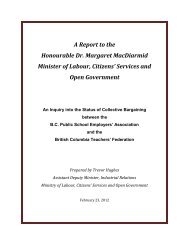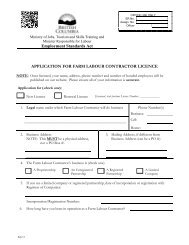Appendix â Glossary of Terms
Appendix â Glossary of Terms
Appendix â Glossary of Terms
You also want an ePaper? Increase the reach of your titles
YUMPU automatically turns print PDFs into web optimized ePapers that Google loves.
Ministry <strong>of</strong> Labour and Citizens’ Services<strong>Appendix</strong> – <strong>Glossary</strong> <strong>of</strong> <strong>Terms</strong>Alternative Service Delivery: refers to the range <strong>of</strong> models through which service delivery tocustomers may be managed. It transforms how government services and operations are deliveredthrough strategic partnerships with the private sector.Alternative Service Delivery solutions help to:• drive cost savings or avoid future costs — such as capital required to build new systems;• enhance service levels;• increase private sector involvement in the delivery <strong>of</strong> services, thereby allowing government t<strong>of</strong>ocus on its core business;• access innovation, creativity and specialized private sector resources;• support economic development and growth in British Columbia; and• ensure appropriate allocation <strong>of</strong> risk.Some examples <strong>of</strong> Alternative Service Delivery are: outsourcing; public-private partnerships (P3s);and shared services.The Alternative Service Delivery Project Secretariat focuses on providing overall governance totransformational projects (such as outsourcing arrangements) and on transferring knowledge andskills to ensure that government has the capability to handle sophisticated Alternative ServiceDelivery initiatives.Benchmarking: the continuous process <strong>of</strong> measuring products, services, and practices against strongcompetitors or recognized industry leaders. It is an ongoing activity that is intended to improveperformance and can be applied to many facets <strong>of</strong> operation. Benchmarking requires a measurementmechanism so that the performance “gap” can be identified. It focuses on comparing best practicesamong similar enterprises.Broadband: broadband technology refers to high-speed Internet access, which makes it possible tosend text, video and voice by cable, digital subscriber line, fibre optics, or wireless connections. Iteliminates waiting for dial-up connections and greatly improves the efficiency and ease-<strong>of</strong>-using theInternet.Broader Public Sector: other levels <strong>of</strong> government (federal and municipal governments) and otherpublic sector agencies that provide services. These include regional health authorities, schools anduniversities, and provincial Crown corporations.Carbon Neutral: Carbon neutrality is a process <strong>of</strong> continuous improvement intended to reduce thenegative effects <strong>of</strong> an organization’s GHG emissions. The process involves:• Measuring the organization’s GHG emissions• Taking steps to reduce its emissions wherever possible• Netting to zero, remaining emissions through <strong>of</strong>fsets – investments in emission reductions elsewhere(e.g., in solar or wind energy technologies outside the provincial public sector).Channels: routes used by citizens, businesses and visitors to access communications — generallytelephone, in person or via the Internet.
Ministry <strong>of</strong> Labour and Citizens’ ServicesClient (see also customer): the decision-maker for a public sector organization that purchases theservice solutions <strong>of</strong>fered by the Ministry <strong>of</strong> Labour and Citizens’ Services.Examples <strong>of</strong> clients include: ministries that purchase common information technology services,payroll services, financial and business applications services and procurement and supply services.Climate Change: “Climate change” can mean a change in climate due to natural or human(anthropogenic) causes. Increasingly, the term has come to refer specifically to that part <strong>of</strong> climatevariation resulting from human-induced greenhouse gas emissions. Thus, the United NationsFramework Convention on Climate Change, in its Article 1, defines climate change as: a change <strong>of</strong>climate, which is attributed directly or indirectly to human activity that alters the composition <strong>of</strong> theglobal atmosphere, and which is in addition to natural climate variability observed over comparabletime periods.Community: any location in British Columbia with a place name and either a public school, library,or health care facility (as defined by the Premier’s Technology Council).Customer (see also client): an individual or end-user who receives a service or product fromCitizens’ Services. Customers may be members <strong>of</strong> the public, businesses, or government staff.Examples <strong>of</strong> customers include:• a citizen who visits one <strong>of</strong> Service BC’s <strong>of</strong>fices in a community to enquire about the programs <strong>of</strong> theMinistry <strong>of</strong> Employment and Income Assistance; and• government staff who contact the Shared Services BC Service Desk to resolve an informationtechnology issue, or contact Corporate Accounting Services to track and reconcile payments tovendors.Economies <strong>of</strong> Scale: the benefit that larger production volumes allow fixed costs to be spread overmore units lowering the average unit costs and <strong>of</strong>fering a competitive price and margin advantage.Producing in large volume <strong>of</strong>ten generates economies <strong>of</strong> scale. The per unit cost <strong>of</strong> material goesdown with volume because vendors charge less per unit for larger orders, and <strong>of</strong>ten productiontechniques and facilities cost less per unit as volume increases. Fixed costs are spread over a largervolume.e-government: government activities that take place by digital processes over computer networks,usually the Internet, between the government and members <strong>of</strong> the public and entities in the privatesector, especially regulated entities. These activities generally involve the electronic exchange <strong>of</strong>information to acquire or provide products or services, to place or receive orders, to provide or obtaininformation, or to complete financial transactions. The anticipated benefits <strong>of</strong> e-government includereduced operating costs for government institutions and regulated entities, increased availability sincegovernment services can be accessed from virtually any location, and convenience due to round-theclockavailability. In addition, e-government provides direct communications between legislators andtheir constituents via email.The Office <strong>of</strong> the Government Chief Information Officer has developed an e-Government Strategywhich includes the e-Government Delivery Framework. This framework illustrates the key elementsin the implementation <strong>of</strong> the e-government plan.
Ministry <strong>of</strong> Labour and Citizens’ ServicesGovernance: the Government Chief Information Officer establishes the decision-making structureand accountabilities associated with the use <strong>of</strong> information and information technology acrossgovernment, including co-ordinating the Information Resource Management Planning process,developing the e-BC Strategy on electronic service delivery, and oversight governance <strong>of</strong> projectssuch as bridging the digital divide. In addition, the Government Chief Information Officer hasresponsibility for the corporate privacy and information access functions <strong>of</strong> government.High Performance (Green) Buildings: are buildings or facilities that are designed to beenvironmentally sustainable. They <strong>of</strong>fer superior economic, environmental and social benefits,including: lower operating costs (energy, water, maintenance); enhanced indoor work environments;and efficient use <strong>of</strong> resources (energy, water, materials).Information Management: the function <strong>of</strong> managing information as an enterprise resource,including planning, organizing and staffing, leading and directing, and controlling information.Information management includes managing data as the enterprise knowledge infrastructure andinformation technology as the enterprise information technical infrastructure, and managingapplications across business value chains.Information Technology: general term used to describe technologies that help produce, manipulate,store, communicate, or disseminate information, including both hardware and s<strong>of</strong>tware.Multi-lingual Services: a corporate service delivery approach is being developed to enhancemultilingual access to information and services in order to better address the multilingual diversityand, hence, the multicultural diversity <strong>of</strong> residents <strong>of</strong> British Columbia. This project is a component<strong>of</strong> the citizen-centered service delivery initiative.Network BC: this project <strong>of</strong>fice was created to respond to the New Era commitment to connect everyB.C. community to high-speed broadband.Outsourcing: a form <strong>of</strong> alternative service delivery. It involves the contracting out <strong>of</strong> workpreviously done within an organization to an external service provider specializing in that type <strong>of</strong>operation/service. It is a business decision that is <strong>of</strong>ten made to achieve cost savings/efficiencies or toimprove service quality and allow the organization to focus on core functions/competencies.Shared Services: means that all ministries share a common set <strong>of</strong> internal management services(information technology, payroll, procurement and supply, strategic acquisitions and intellectualproperty, financial and business applications and real estate and accommodation), rather thanduplicating these functions across ministries. Shared services is a “best practice” approach to reducingcosts. Creating a shared services organization involves more than consolidation. It includes:• modifying policies and streamlining processes;• standardizing processes to leverage expertise;• using technology to drive out further efficiencies;• driving continuous improvement; and• aggregating volumes to achieve economies <strong>of</strong> scale.The shared services approach has other characteristics that set it apart as well. Shared services isclient-led. Clients are involved in determining the services they want to receive. Shared servicesorganizations value and use input from clients and industry experts to continuously improve servicedelivery and reduce costs. Generally speaking, governance (rules, policies and regulations) isseparated from the delivery <strong>of</strong> services to ensure the organization focuses on service delivery.


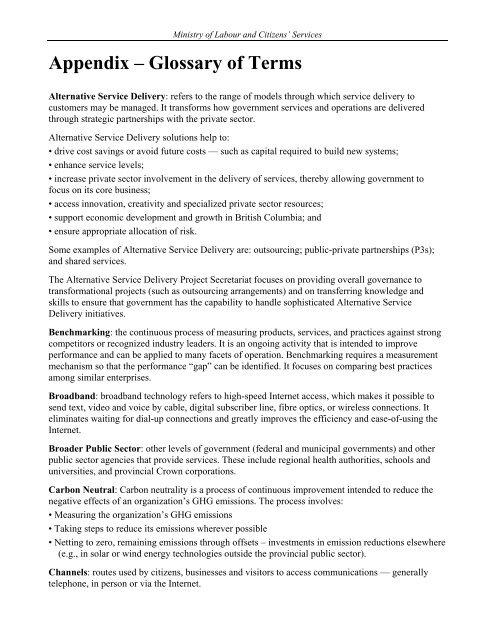
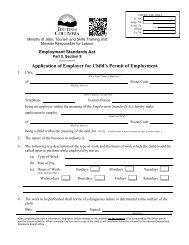
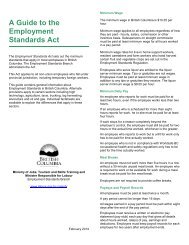
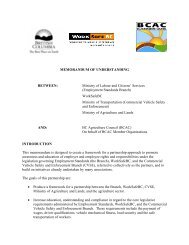

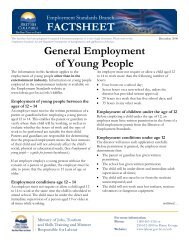

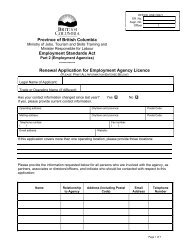
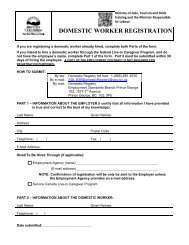
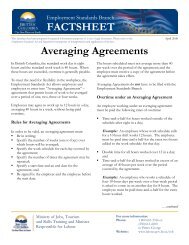
![PDF format [222KB] - Jobs, Tourism and Skills Training](https://img.yumpu.com/36342804/1/190x245/pdf-format-222kb-jobs-tourism-and-skills-training.jpg?quality=85)
![PDF format [56KB] - Ministry of Jobs, Tourism and Skills Training](https://img.yumpu.com/36340607/1/190x245/pdf-format-56kb-ministry-of-jobs-tourism-and-skills-training.jpg?quality=85)

